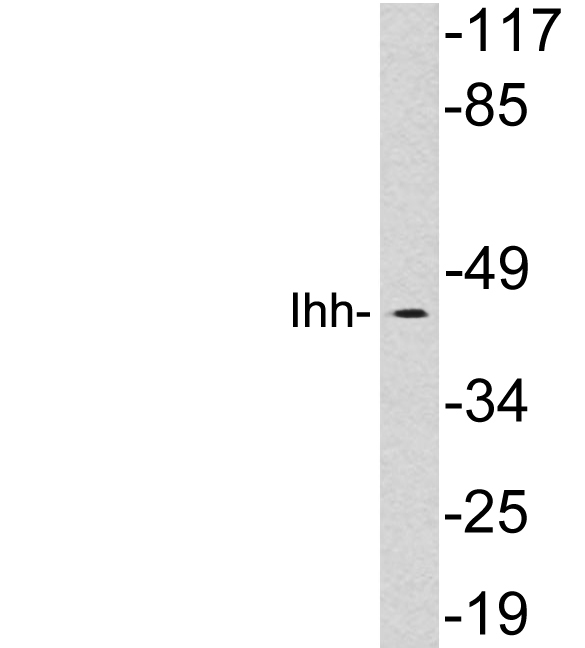产品名称
Ihh Rabbit Polyclonal Antibody
别名
IHH; Indian hedgehog protein; IHH; HHG-2
蛋白名称
Indian hedgehog protein
存储缓冲液
Liquid in PBS containing 50% glycerol, 0.5% BSA and 0.02% New type preservative N.
Human Gene Link
http://www.ncbi.nlm.nih.gov/sites/entrez?db=gene&term=3549
Human Swissprot No.
Q14623
Human Swissprot Link
http://www.uniprot.org/uniprotkb/Q14623/entry
Mouse Gene Link
http://www.ncbi.nlm.nih.gov/sites/entrez?db=gene&term=16147
Mouse Swissprot No.
P97812
Mouse Swissprot Link
http://www.uniprot.org/uniprot/P97812
免疫原
The antiserum was produced against synthesized peptide derived from human Ihh. AA range:209-258
特异性
Ihh Polyclonal Antibody detects endogenous levels of Ihh protein.
稀释度
WB 1:500 - 1:2000. ELISA: 1:20000. Not yet tested in other applications.
宿主
Polyclonal, Rabbit,IgG
背景介绍
This gene encodes a member of the hedgehog family of proteins. The encoded preproprotein is proteolytically processed to generate multiple protein products, including an N-terminal fragment that is involved in signaling. Hedgehog family proteins are essential secreted signaling molecules that regulate a variety of developmental processes including growth, patterning and morphogenesis. The protein encoded by this gene specifically plays a role in bone growth and differentiation. Mutations in this gene are the cause of brachydactyly type A1, which is characterized by shortening or malformation of the fingers and toes. Mutations in this gene are also the cause of acrocapitofemoral dysplasia. [provided by RefSeq, Nov 2015],
组织表达
Expressed in embryonic lung, and in adult kidney and liver.
细胞定位
[Indian hedgehog protein N-product]: Cell membrane ; Lipid-anchor ; Extracellular side . The N-terminal peptide remains associated with the cell surface. .; [Indian hedgehog protein C-product]: Secreted, extracellular space . The C-terminal peptide diffuses from the cell. .; Cell membrane .
功能
disease:Defects in IHH are a cause of acrocapitofemoral dysplasia (ACFD) [MIM:607778]. ACFD is a disorder characterized by short stature of variable severity with postnatal onset. The most constant radiographic abnormalities are observed in the tubular bones of the hands and in the proximal part of the femur. Cone-shaped epiphyses or a similar epiphyseal configuration with premature epimetaphyseal fusion result in shortening of the skeletal components involved. Cone-shaped epiphyses were also present to a variable extent at the shoulders, knees, and ankles.,disease:Defects in IHH are the cause of brachydactyly type A1 (BDA1) [MIM:112500]. BDA1 is an autosomal dominant disorder characterized by middle phalanges of all the digits rudimentary or fused with the terminal phalanges. The proximal phalanges of the thumbs and big toes are short.,function:Intercellular signal essential for a variety of patterning events during development. Binds to the patched (PTC) receptor, which functions in association with smoothened (SMO), to activate the transcription of target genes. Implicated in endochondral ossification: may regulate the balance between growth and ossification of the developing bones. Induces the expression of parathyroid hormone-related protein (PTHRP).,PTM:Cholesterylation is required for N-product targeting to lipid rafts and multimerization.,PTM:Palmitoylated. N-palmitoylation is required for N-product multimerization and full activity.,PTM:The C-terminal domain displays an autoproteolysis activity and a cholesterol transferase activity. Both activities result in the cleavage of the full-length protein and covalent attachment of a cholesterol moiety to the C-terminal of the newly generated N-terminal fragment (N-product). The N-product is the active species in both local and long-range signaling, whereas the C-product has no signaling activity.,similarity:Belongs to the hedgehog family.,subcellular location:The C-terminal peptide diffuses from the cell.,subcellular location:The N-terminal peptide remains associated with the cell surface.,tissue specificity:Expressed in embryonic lung, and in adult kidney and liver.,
纯化
The antibody was affinity-purified from rabbit antiserum by affinity-chromatography using epitope-specific immunogen.


